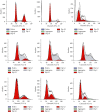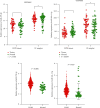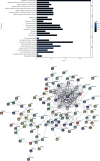Mangiferin Inhibits Human Lung Adenocarcinoma by Suppressing MiR-27b and MiR-92a
- PMID: 34335801
- PMCID: PMC8292060
- DOI: 10.1155/2021/2822950
Mangiferin Inhibits Human Lung Adenocarcinoma by Suppressing MiR-27b and MiR-92a
Abstract
Lung adenocarcinoma (LUAD) is one of the most prevalent malignancies. However, its mechanism and therapeutic strategy remain to be clarified. Mangiferin is a flavonoid derived from the leaves of mango trees of the lacquer family that has many pharmacological and physiological effects. This research aimed to elucidate the biological effect of mangiferin in LUAD cell lines and clarify the in vitro mechanism of mangiferin. Mangiferin was shown to significantly restrain the proliferation of LUAD cells (A549, H1299, and H2030 cells) in a dose- and time-dependent manner. Furthermore, mangiferin was capable of stimulating apoptosis, and more cells were blocked in G1 and S phase in the mangiferin-treated cells than in those not treated with mangiferin. Microarrays and micro-RNA sequencing data suggested that there is a higher level of miR-27b and miR-92a in LUAD tissues than in non-LUAD tissues. Additional experiments indicated that mangiferin may be related to the downregulated levels of miR-92a and miR-27b. In conclusion, mangiferin likely regulates proliferation and apoptosis in LUAD cells by reducing the expression levels of miR-92a and miR-27b.
Copyright © 2021 Xiao-Jv Chi et al.
Conflict of interest statement
The authors declare that they have no conflicts of interest.
Figures







Similar articles
-
Circle RNA FOXP1 promotes cell proliferation in lung cancer by regulating miR-185-5p/Wnt1 signaling pathway.Eur Rev Med Pharmacol Sci. 2020 Jun;24(12):6767-6778. doi: 10.26355/eurrev_202006_21665. Eur Rev Med Pharmacol Sci. 2020. PMID: 32633368
-
Mangiferin regulates proliferation and apoptosis in glioma cells by induction of microRNA-15b and inhibition of MMP-9 expression.Oncol Rep. 2015 Jun;33(6):2815-20. doi: 10.3892/or.2015.3919. Epub 2015 Apr 21. Oncol Rep. 2015. PMID: 25901555
-
Sp1-induced upregulation of the long noncoding RNA TINCR inhibits cell migration and invasion by regulating miR-107/miR-1286 in lung adenocarcinoma.Am J Transl Res. 2019 Aug 15;11(8):4761-4775. eCollection 2019. Am J Transl Res. 2019. PMID: 31497197 Free PMC article.
-
MiR-188 inhibits proliferation and promotes apoptosis of lung adenocarcinoma cells by targeting SIX1 to negatively regulate ERK signaling pathway.Eur Rev Med Pharmacol Sci. 2020 Jan;24(2):721-727. doi: 10.26355/eurrev_202001_20051. Eur Rev Med Pharmacol Sci. 2020. PMID: 32016974
-
Good or not good: Role of miR-18a in cancer biology.Rep Pract Oncol Radiother. 2020 Sep-Oct;25(5):808-819. doi: 10.1016/j.rpor.2020.07.006. Epub 2020 Aug 12. Rep Pract Oncol Radiother. 2020. PMID: 32884453 Free PMC article. Review.
Cited by
-
Mangiferin: An effective agent against human malignancies.Food Sci Nutr. 2024 Sep 8;12(10):7137-7157. doi: 10.1002/fsn3.4434. eCollection 2024 Oct. Food Sci Nutr. 2024. PMID: 39479608 Free PMC article. Review.
-
Role of Mangiferin in Management of Cancers through Modulation of Signal Transduction Pathways.Biomedicines. 2023 Dec 1;11(12):3205. doi: 10.3390/biomedicines11123205. Biomedicines. 2023. PMID: 38137424 Free PMC article. Review.
-
Bioactive components and the molecular mechanism of Shengxian Decoction against lung adenocarcinoma based on network pharmacology and molecular docking.Am J Transl Res. 2023 Dec 15;15(12):6988-7012. eCollection 2023. Am J Transl Res. 2023. PMID: 38186989 Free PMC article.
-
Chemical and Biological Evidence of the Efficacy of Shengxian Decoction for Treating Human Lung Adenocarcinoma.Front Oncol. 2022 Mar 18;12:849579. doi: 10.3389/fonc.2022.849579. eCollection 2022. Front Oncol. 2022. PMID: 35372052 Free PMC article.
-
Connection between Radiation-Regulating Functions of Natural Products and miRNAs Targeting Radiomodulation and Exosome Biogenesis.Int J Mol Sci. 2023 Aug 4;24(15):12449. doi: 10.3390/ijms241512449. Int J Mol Sci. 2023. PMID: 37569824 Free PMC article. Review.
References
-
- Global Burden of Disease Cancer Collaboration, Fitzmaurice C., Abate D., et al. Global, regional, and national cancer incidence, mortality, years of life lost, years lived with disability, and disability-adjusted life-years for 29 cancer groups, 1990 to 2017: a systematic analysis for the global burden of disease study. JAMA Oncology. 2019;5(12):1749–1768. doi: 10.1001/jamaoncol.2019.2996. - DOI - PMC - PubMed
LinkOut - more resources
Full Text Sources

